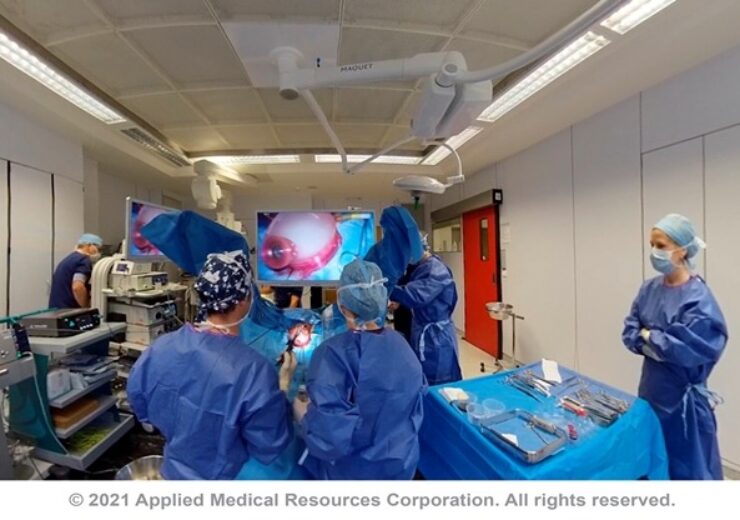vNOTES Approach Shown to Shorten Hospital Stay, Lower Pain Scores and Increase Patient Satisfaction

vNOTES (vaginal natural orifice transluminal endoscopic surgery) procedure. (Credit: Business Wire)
Clinical studies demonstrate the considerable patient benefits of the vaginal natural orifice transluminal endoscopic surgery (vNOTES) technique – a new, modern approach to vaginal surgery. Vaginal hysterectomy is the recommended approach by the American Association of Gynecologic Laparoscopists (AAGL) and American College of Obstetricians and Gynecologists (ACOG) whenever indicated and feasible.
Despite these recommendations and supporting clinical evidence, the rate of vaginal hysterectomies in the U.S. has steadily declined due to lack of visibility and reduced access to the anatomy. The vNOTES technique overcomes these challenges by combining the benefits of laparoscopic and traditional vaginal surgery using the Applied Medical GelPOINT® V-Path transvaginal access platform, which enables access into the peritoneal cavity through the vagina.
Literature indicates that vNOTES may now be the preferred method for hysterectomy and adnexectomy, even in complex cases of large uteri or high body mass index, compared to conventional laparoscopic and vaginal approaches. Multiple studies cite improved patient outcomes and benefits, including shorter duration of surgery and length of stay, lower pain scores and total dose of analgesics, and higher patient satisfaction.
“At Applied Medical we are proud to collaborate with the surgical community to develop a solution that positively impacts women’s lives. One in three women will receive a hysterectomy by the age of 60. With vNOTES, these women can now have not only a scarless surgery, but also one that allows them to get back to their busy lives more quickly,” said Serene Wachli, group president of the Horizon II Division at Applied Medical. “We are excited to see the growth in adoption of vNOTES as it represents a significant advancement in women’s healthcare.”
The following clinical studies highlight recent research about the vNOTES technique and mounting clinical evidence for its benefits to patients.
The “Comparison of vNOTES and Conventional Laparoscopy in Opportunistic Bilateral Salpingectomy for Permanent Female Sterilization” study, published in August 2021 in The Journal of Minimally Invasive Gynecology (JMIG), found that women who underwent the vNOTES approach for bilateral salpingectomy had higher satisfaction, less postoperative pain, lower analgesic requirements and similar surgical outcomes compared to those who had a conventional laparoscopic procedure. This same study noted that, “vNOTES may overcome the difficulty and potential limitations of vaginal surgeries and could broaden indications of conventional vaginal surgery.”
The “Adnexectomy by vNOTES Versus Laparoscopy: Results of a First Randomized Controlled Trial (NOTABLE Trial),” published in July 2021 in BJOG: An International Journal of Obstetrics and Gynaecology, validated that the vNOTES approach for adnexectomy resulted in shorter duration of surgery, lower pain scores and lower total dose of analgesics when compared to the laparoscopic approach.
“The Comparison of Surgical Outcomes Following Laparoscopic Hysterectomy and vNOTES Hysterectomy in Obese Patients” study, published in May 2021 in the Journal of Investigative Surgery, found that obese patients who underwent a vNOTES procedure benefited from a shorter duration of surgery and postoperative hospitalization and had lower pain scores.
The “Systematic Review and Meta-analysis on Hysterectomy by vNOTES Compared to Laparoscopic Hysterectomy for Benign Indications,” published in December 2020 in the Journal of Clinical Medicine, found vNOTES resulted in significantly lower values for operation time, length of stay and estimated blood loss.
The “vNOTES Hysterectomy for Large Uteri: A Retrospective Cohort Study of 114 Patients,” published in October 2020 in JMIG, reported on the successful performance of hysterectomies using vNOTES for patients not typically indicated for vaginal surgery due to large uteri, a history of cesarean section, nulliparity or obesity.
“I have conducted more than 2,000 vNOTES procedures and it has become the default technique in my practice for all benign gynecological surgeries,” said Jan Baekelandt,3 MD, PhD, Consultant, Gynecological Oncology and MIS, AZ Imelda Hospital, Bonheiden, Belgium. “We have found that with vNOTES patients recover more quickly and have less postoperative pain. Additionally, the operating room time for the procedure is shorter and results in fewer intraoperative and postoperative complications.”
“vNOTES solves the challenges of vaginal surgery by allowing additional visualization. It enables you to see the patient’s anatomy, as well as any scar tissue or adhesions,” said Erica Stockwell,4 DO, MBA, FACOG, Advanced Gynecologic Surgeon, AdventHealth, Celebration, Florida. “Since starting vNOTES, the improvement in my patients’ recovery experience has been tremendous. They have almost no pain at all. Most of my patients are able to leave the same day as the surgery.”
Applied Medical is hosting a virtual and in-person symposium, “vNOTES: The Technique Every MIGS Surgeon Should Know,” at the American Association of Gynecologic Laparoscopists (AAGL) 50th Global Congress on MIGS on November 16, 2021. Expert panelists will discuss their diverse experience with the vNOTES technique, the clinical evidence and the associated patient outcomes.
Applied Medical supports the education and adoption of the vNOTES technique by facilitating global vNOTES training courses for qualified surgeons.
Source: Company Press Release
